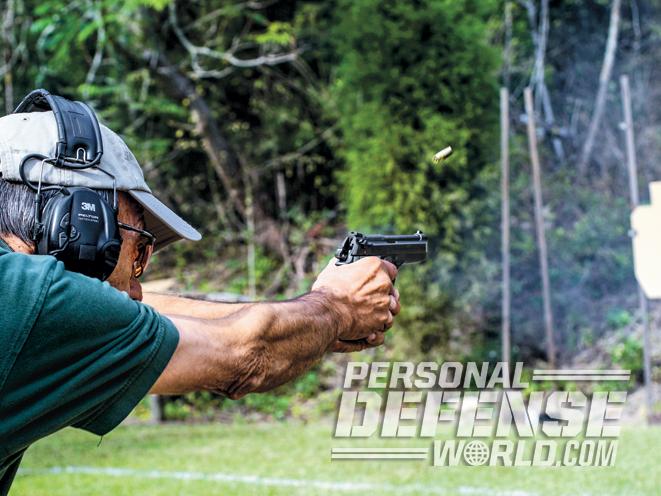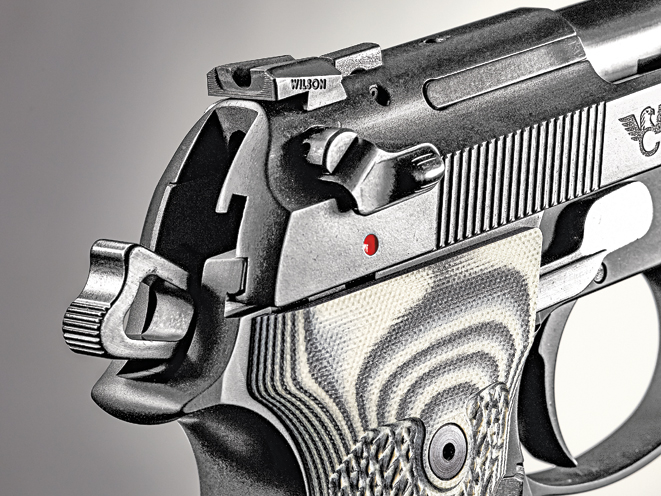One of last year’s big success stories in handguns was Wilson Combat’s iteration of the Beretta 92G, the Brigadier Tactical that has become known as the Brig-Tac. It sported the heavy-duty Brigadier slide, the accessory rails of the M9A1, Wilson Battlesights, G10 stocks and, above all, a super-sweet action. Gunsmithing legend Bill Wilson, long a Beretta fan himself, brought master Beretta-smith and shooting champ Ernest Langdon to his Berryville, Arkansas, plant to teach several of WC’s master craftsmen how to do an action job like Langdon’s. The result? The Brig-Tac has been back-ordered ever since, with thousands already in the hands of very satisfied customers.
Now comes the second iteration, the Wilson Combat 92G Compact Carry. It has the fast-ignition, skeletonized Elite II hammer of the Brig-Tac, and is built on Beretta’s long-standing Compact frame and barrel/slide. On this one, the accessory rail is gone. Bill told me, “A lot of our customers just didn’t seem to want it.” That’s OK with me: For us old gunnies, in a time when holsters for railed Berettas are still kind of thin on the ground, the new pistol fits fine in the Beretta holsters we’ve accumulated over the course of decades.
The Battlesight is still there at the rear, but the front sight is an ordinary post with a white dot that’s integral with the slide. Why? Bill explained, “That’s how Beretta is making the Compact slides, and they won’t have dovetailed fronts for other sights until the factory moves to Tennessee from Maryland. I didn’t want to wait that long to build this gun.” Also present on the new pistol is the oversized WC magazine release, a greatly appreciated feature on the Brig-Tac. A steel recoil spring guide rod and match-grade barrel are there, too. Bill noted that the Compact Carry concept evolved at Wilson Combat in approximately May of 2015. The first production guns were hitting Arkansas for their Wilson treatment in mid-December of that year, and that’s why our “first-look” sample of the Compact Carry is a prototype.
Advertisement — Continue Reading Below
The pistol’s finish is standard Beretta: an anodized frame and a Bruniton-treated slide. The Langdon-inspired Wilson Combat action job is an extra $110, and I would strongly urge you to go that route. From a shooter’s perspective, the action work truly made this fine handgun package.
Pulling Away

Many thousands of my students have heard me say, “Trigger pull is the heart of the beast,” when we’re talking about getting an accurate hit. There is far more than pull weight to consider here, but that measurement is indeed one factor.
Advertisement — Continue Reading Below
In double action, measuring from the toe of the trigger, where leverage is greatest with a pivoting trigger like the Beretta’s, pull weight on the Lyman digital scale measured an amazingly light (for this type of pistol) 5.99 pounds. However, normal human fingers generally press the trigger rearward from its center, which reduces leverage and therefore increases the weight of the real-world trigger pull. That measurement on the test Wilson/Beretta Compact Carry ran 8.31 pounds. That’s not bad at all, and the pistol turned out to be very controllable throughout testing.
RELATED STORY: Massad Ayoob Reviews the Beretta/Wilson Combat 92G Brigadier Tactical
Bill Wilson likes his Berettas in the 92G configuration. This means that it’s a traditional double action, with the long and relatively heavy trigger pull required only for the very first shot, and the mechanism cocking itself to a lighter, shorter single-action pull for every shot thereafter, unless and until the shooter thumbs the slide-mounted decocking lever down and resets the pistol to double action. For those new to the long epoch of the Beretta 92 pistols, the difference is that the “D” series decocks itself to a double-action pull for every shot, and the “F” series’ slide-mounted lever is both a decocker and a safety, meaning that when you thumb the lever down it stays down in an “on safe” position and won’t fire until that same lever is thumbed back up into the “fire” position.”
Advertisement — Continue Reading Below
So, of course, we had to test the trigger on single-action, too, since that’s every shot fired after the first one. From the toe of the trigger that most human fingers don’t reach when firing a pistol, pull weight averaged 3.38 pounds.However, from the center of the trigger where real-world fingers generally fire shots, the lesser leverage equated to 4.33 pounds of pull weight. Bill Wilson told me the guns that leave his shop will be spec’d for a 9-pound double-action pull and a 4-pound single-action pull.
Making The Grade

I used this test pistol to teach a third-level (MAG-120) class for the Massad Ayoob Group in December 2015. The pistol never failed me. A requirement to pass is a satisfactory score on a triple-speed police-type qualification, with times like “draw and fire one hand only, six rounds, 2.66 seconds.” We use the IPSC target, which has smaller scoring zones for qualification than almost any other silhouette target out there.
Advertisement — Continue Reading Below
Every student gets multiple tries; I shoot it once cold in demo, and anyone who beats me gets an autographed $5 bill that says so. Using American Eagle ball ammo and an Alessi CQC-S holster designed by my friend Dave Spaulding, I managed a 290, and out of 20 scores or so on the board I only had to pay out a single $5 bill. My friend, colleague and student Dave Maglio, one of the staff instructors, got me by two points. Dave is a former Midwest champion IDPA shooter in Stock Service Pistol, and I’m never embarrassed to lose to him. In fact, I got to use a line from our mutual friend and fellow instructor Andy Kemp: “Dude, you’re 17 years younger than me! You should have beat me by way more than two points!” In any case, my points down were my fault, not the Beretta’s.
True Testimonials

The Wilson Combat/Beretta 92G Compact Carry was one of several interesting new handguns I had in for testing and passed around to the students in that class to test-fire. Here are some of their comments:
Advertisement — Continue Reading Below
Dave Rodgers, an experienced instructor and competitive shooter, said: “The double action was really smooth…but once I got to the second shot, it felt like cheating—holes in holes at 7 yards. It fit my hand perfectly…I would consider it as the next pistol I would like to buy.”
RELATED STORY: VIDEO – Beretta, Wilson Combat Unveil 92G Compact Carry Pistol
Andrew Fritzinger, a seasoned pistol and rifle shooter whose day job involves a different but related type of threat management, noted, “Extremely smooth trigger and cycling. Full-size 1911 accuracy in a compact double-action pistol. Nickel/quarter-size groups from standing at 7 yards with Blazer Brass 115-grain FMJ ammo. Easy to obtain a crush grip, unlike many compact carry guns. I want one!”
Advertisement — Continue Reading Below
Competitive shooter Rich Givens, said, “Smooth action, minimal felt recoil, excellent accuracy.”
“J,” a high-speed/low-drag warrior who is deeply experienced with the Beretta 9mm in combat and whose name can’t be used here because he’s still working for Uncle Sam, said: “I wish I had this gun in the military in Afghanistan. It is the smoothest Beretta out there. That smooth trigger translates into the tightest shot groups.”
From The Bench
Advertisement — Continue Reading Below

I routinely test for accuracy using a Caldwell Matrix rest on a concrete bench at a measured 25 yards, measuring center to center to the nearest 0.05 inches for the farthest-apart shots, and take two such measurements. One is for all the shots in the traditional five-shot group, and the other is for the best three of those. The reason is that decades of shooting have taught me that the “best three” measurement will roughly equal what the same gun would do for all five shots from a machine rest with the same ammo, and since most of my readers don’t have machine rests, that gives them a benchmark for comparison. The “best three” allows for unnoticed human error on the part of the shooter. With this Wilson/Beretta pistol, I used examples of the three most popular bullet weights in 9mm ammunition today.
It just seemed right to use Wilson Combat’s own 9mm ammunition for at least part of the test, and I chose the company’s 115-grain TAC-XP rounds, which uses the dynamic Barnes all-copper, hollow-point bullet loaded to give a velocity of 1,200 fps from a 5-inch barrel. This proved to be the most accurate (in terms of shooting to where the sight picture was) and the most precise (in terms of group size).
Advertisement — Continue Reading Below
RELATED STORY: 3 Carry-Ready Wilson Combat Sentinels
The group centered on the center X-ring of the little Birchwood Casey “Big Burst” target 25 yards away, and all five shots were 2.85 inches apart center to center. However, four of them were in barely more than half that, at 1.45 inches, and the best three were a mere 0.65 inches apart. Two-thirds-of-an-inch groups, particularly when they’re in the X-ring when the gun comes out of the box, are always pleasing.
For a 124-grain load, I used Nosler’s Match Grade jacketed hollow point. These delivered 3.75-inch groups for all five (see why I do that “best three” measurement?), 2.3 inches for four of them and 1.6 inches for the best three.
The 147-grain subsonic 9mm load tends to be extremely accurate, and full-metal-jacket, truncated-cone Winchester training loads delivered 3 inches even, with four of them in exactly 2 inches, with a best three of 1.9 inches. As is usual with 9mm pistols, the 147- grain load grouped distinctly larger than the 115- and 124-grain loads.
Daily Carry

Back in 1987, when I first trained some instructors for the U.S. Army, I got to like the Beretta 92/M9, but always found the full-sized model a little big for me, so I bought a Compact. In 1996 my older daughter, then 19, borrowed that 92 Compact tuned by Jim Horan and won High Woman at the National Tactical Invitational, so naturally it became hers and she has it to this day.
My personal favorite Beretta 92 for daily carry is a more recent Compact in stainless with a light rail (the M9A1 configuration), which Wilson Combat slicked up and refinished for me. The shorter grip frame just fits my hand better, and not being a big guy, on my strong-side hip the Compact is just short enough that I don’t have to adjust my posture when seated behind a steering wheel. All that makes the trade-off of 14 rounds instead of 16 seem fair.
RELATED STORY: Wilson Combat 1911s – From Covert Carry to Range Competition
The test Wilson/Beretta Compact Carry’s G10 grips offered a great hold when shooting, and were no problem in concealed carry inside the waistband (using a Galco NSA holster) or outside (using the Alessi CQC). Not until I wore it under an untucked polo shirt next to bare skin inside the waistband did I detect the slightest abrasion of skin, and “slightest” is the operative term there. In about two weeks of daily concealed carry, with the gun on from when I got dressed in the morning to when I undressed for bed, I was comfortable with the Wilson/Beretta 92G Compact Carry.
It’s clear to me that Wilson Combat has another winner with the Compact Carry version of the Beretta 92G. With an MSRP of $1,095, plus $110 for the action work, when you look at its features and figure what an action job of this quality would cost, it’s a damn good value. How good? Instead of sending the gun back to Wilson, I sent a check to buy it.
For more information, call 800-955-4856 or visit http://www.wilsoncombat.com.



































